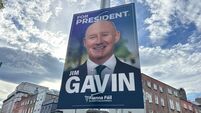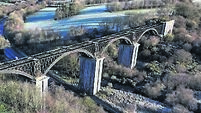Irish Examiner view: Two-state option is the viable solution for Israel and Palestine

The proposed two-state solution in the Holy Land proffers no more and no less than the peaceful co-existence of Palestine and Israel. Picture: iStock
A two-state solution in the Holy Land, whereby a Palestinian nation will be established and allowed co-exist alongside Israel, is once more becoming obvious as the only genuine answer to solving the seemingly endless warfare in the region.
The merciless horror that has been visited upon the Palestinian people over the last two years by Israel requires a solution and there is an increasing realisation that the battle lines between moderate and extremist visions for the future of Gaza and the West Bank are becoming clearer.
On one hand, you have the views of such as Israeli prime minister Benjamin Netanyahu and his voluble far-right minister for finance, Bezalel Smotrich, backed by the benign inaction of the White House in Washington, trying to bury — literally — the two-state vision.
On the other, there are those increasingly nauseated by what the Israeli government is doing, who have finally realised that that goal — of two countries living alongside each other harmoniously — will be dug into Palestinian soil unless they act now.
The French and British have indicated their willingness to finally recognise Palestinian statehood, but only because the increasingly genocidal administration in Tel Aviv is demonstrating little enthusiasm for any potential settlement.
Certainly, we are going to have to see, amongst other things, a reformed Palestinian Authority come into being if the Israeli government is to stop waging war in Gaza and make the two-state solution workable, but such an outcome is far from being beyond the realms of possibility.
Hamas is not helping its cause, or that of the people it claims to represent, by screening images of skeletal hostages. Indeed, it is only buttressing hardline Israeli views.
All concerned have to come to the realisation that the two-state option is the only realistic and workable solution and the sooner the increasingly entrenched radical views on either side come to this conclusion, the sooner the bloodshed will stop.
Not alone has Donald Trump changed the face of global trade with his scattergun tariffs, but he and his administration are engaged in a witchhunt — a favourite word of the US president — against a wide array of American media outlets and outspoken academics, which is threatening the very fabric of democracy there.
Trump has effectively silenced much of the media criticism against him personally, and his wider regime, because corporate owners fear his wrath. CBS — along with parent company Paramount — effectively fired the hugely popular late-night show host Stephen Colbert in order to secure administration approval of the sale of Paramount to Skydance.
Similarly, Amazon billionaire and owner Jeff Bezos silenced any criticism of the Trump regime on the editorial pages of his newspaper, because he fears the wrath of Trump will impact on his businesses’ profitability.
So too American universities — for eons bastions of democracy and free speech — have had to crawl cap in hand to the White House to get funding restored after incurring that wrath because high-profile staffers have criticised his illegal, unconstitutional actions.
This silencing of media and universities willing to criticise the notoriously thin-skinned Trump is happening across America. However, the shame is on those media outlets and educationalists that have allowed it.
Bezos proudly amplified the ’s ‘Democracy Dies In Darkness’ tagline when he bought the newspaper. Yet he has himself allowed a darkness to descend on one of America’s most valued independent media resources.
The silencing of those who have helped America to understand just how alarming this regime has become is a terrible indictment for a country that prides itself on being the leading player in a ‘Free World’.
The Government’s proposed ban on the inshore fishing of sprat by large trawlers is not before time.
In fact, the move might have come a little too late, as overfishing of the species has already had a dramatic effect on the wellbeing of our native maritime wildlife, from sharks, dolphins, and whales, to sea birds such as puffins and kittiwakes.
As a result of large-scale fishing, sprat numbers have seen a huge decline, and thus reduced the food supply to a wide variety of native species.
The plan to stop trawlers over 18m in size from fishing within six nautical miles of our coastline can only boost sprat numbers, thus improving prospects for other maritime creatures.
Sadly, however, the new restrictions will run only from October 1 until September 30, 2026.
And while it may be that the authorities here are only trialling this inshore fishing ban and planning for more focused action in the future, it seems Government action may have come too late.
For too many years now, the native Irish fishing industry has been treated as the poor relation to the agriculture sector when it comes to doling out necessary financial supports.
This has meant that we have allowed our rich maritime resources to be plundered by other nations who care less about the wellbeing of Irish aquatic wildlife.
Their fishing fleets, invariably better resourced and equipped than ours, do not discriminate in what they catch and therefore species which they have little use for, are arbitrarily and routinely over-fished.
Hopefully, this limited ban will have an immediate effect in conserving a fish vital to our rich and abundant animal kingdom.
It seems almost certain, however, this is a subject that will have to be revisited.















